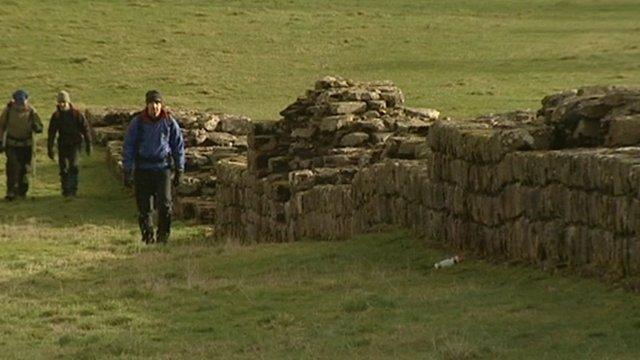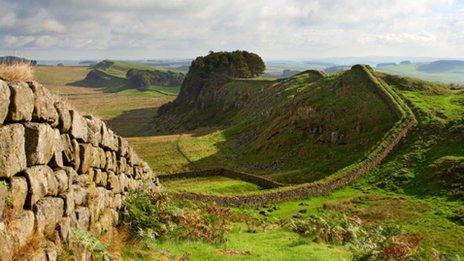Hadrian's Wall: Aerial photographs 'could change history'
- Published

The line of a buried Roman road can be seen approaching the excavated remains of Housesteads fort on Hadrian's Wall

A small archaeological excavation has proved the slight traces of ditch seen on aerial photographs belong to a hitherto unknown, early Roman fort

The line of The Vallum, a massive earthwork barrier south of Hadrian’s Wall, can be seen to the left of the road

Excavations at the vicus (Roman civilian settlement) outside Vindolanda fort are shedding new light on life along the Roman frontier
Hundreds of miles away from Hadrian's Wall, a man surfing the internet from the comfort of his home stumbled across something that astonished the professionals.
Bryn Gethin's discovery on his computer in Warwickshire, was one of a number, based on aerial photography and imaging techniques, that are rewriting a whole era of Roman history.
He spotted something while browsing old LIDAR (light detection and ranging) images, which show remains even if covered by trees or buildings.
Experts say he had potentially discovered the camp of the men who actually built the wall that runs across the country from Tyneside to Cumbria.
Surveyor Humphrey Welfare, currently investigating the site, said the camp would not have been seen without aerial images.
"It gives us another little insight, a little window into what happened during the construction of the wall," he said.
"And that's how archaeology builds up, piece by piece."
It was known the wall supported civilian communities which provided goods and services in a local economy that benefitted both occupiers and natives.
But it seems there were Iron Age settlements hundreds of years before the arrival of the Romans who, rather than being an aggressive conquering force, forged working relationships with the resident population.
'Whole new world'
"What we thought we saw was a very militaristic landscape, very sparsely populated and all we saw was what survived at the surface," said Dr David Woolliscroft from Liverpool University.
"Then suddenly, when we started to fly, a whole new world emerged. Huge numbers - tens of thousands - of isolated farms, completely undefended.
"You can only have a landscape like that when people are so used to peace that they take it for granted.
"And that utterly changes the story of how we see the Romans."
There is also evidence, discovered from the air, that throws into doubt the accepted belief that the wall was a barrier between the empire and the barbarian north.
Aerial pictures of a Roman aqueduct show it built north of the wall and right next to a native settlement.
"That shows a comfort in their own security and power, in that they're happy for something as important as a water resource to be placed north of the frontier," Dave Macleod, from English Heritage aerial survey team, said.
Aerial archaeologist Ben Robinson uncovers new revelations about life on Hadrian's Wall in Northumberland
"You don't put your water supply into enemy hands," Dr Woolliscroft agreed. "Clearly they were very confident that this was an area that was theirs, even though it was beyond the wall."
The area around Hadrian's Wall has been mapped from the air by English Heritage but amateur research has also thrown up some surprising findings.
Ancient camps, ovens, rubbish pits and ditches show up from the air as crop marks, where plants grow differently - often invisible from the ground.
Work on Emperor Hadrian's wall began in AD122.
Archaeologists believed soldiers had settled in a nearby fort - Vindolanda - from about AD85.
But another photograph shows something Dr Andrew Birley from the Vindolanda Trust believes is a fort built ten years earlier, 50 years before the wall.
"As we started excavating the ditches we were getting more and more evidence to suggest that this actually could pre-date anything on this part of the site that we'd previously known about," he said.
If they find the timber fort gates - and it might take years - the rings on the wood could lead conclusively to a construction date.
It might prove the Romans established their frontier long before the history books currently say.
The Flying Archaeologist can be seen in the North East on BBC1 on Friday 19 April at 19:30 BST.
The series will be broadcast nationwide on BBC4 from Monday 29 April at 20:30 BST.
- Published2 February 2013

- Published20 March 2013
